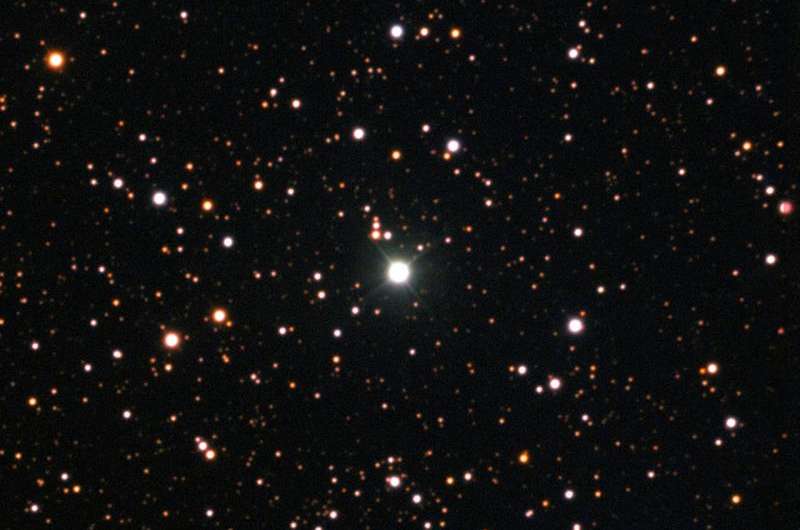This image from the New Technology Telescope at ESO’s La Silla Observatory shows Nova Centauri 2013 in July 2015 as the brightest star in the center of the picture. This was more than eighteen months after the initial explosive outburst. This nova was the first in which evidence of lithium has been found. Credit: ESO
(Phys.org)—An Argentinian team of astronomers from the Astronomical Observatory of Córdoba has announced the finding of a new exceptional young lithium-rich giant star, designated KIC 9821622. Using the data obtained with the high-resolution GRACES spectrograph at the Gemini North telescope in Hawaii, the scientists were able to determine the chemical abundances of 23 elements of this star as well as reveal its mass, radius, and age. The results appear in the December issue of the Astronomy & Astrophysics journal.
According to the findings, KIC 9821622 is a lithium-abundant, intermediate-mass giant star (about 1.64 solar masses) located at the red giant branch near the luminosity bump, approximately 5,300 light years from Earth. Such lithium-rich stars are very rare; it is estimated that only 1 to 2 percent of all observed giants have at least the same amount of this element as KIC 9821622.
The star was observed as one of the first science targets taken for an on-sky test of the GRACES (Gemini Remote Access to CFHT ESPaDOnS Spectrograph). The observations were conducted in July 2015.
Aside from being lithium-rich, the scientists found that KIC 9821622 shows also a high abundance of carbon, nitrogen and oxygen. They also managed to derive the star's precise spectroscopic fundamental parameters, including the effective temperature, surface gravity, metallicity and microturbulent velocity.
Stars destroy most of their lithium soon after formation, consuming it at nuclear fusion temperatures. This element is not normally remade. Thus, what baffles scientists is how giant stars become rich in lithium.
One of the explanations offered by the authors of the newly published paper is that the lithium-rich nature is the result of internal fresh lithium that is synthesized near the luminosity bump. The other possibility taken into account is that it could be caused by the accretion of planets or brown dwarfs. Such planet swallowing could provide a sudden fresh supply of lithium.
"Lithium enhancement in giant stars can be the result of the engulfment of a brown dwarf or planet," the paper reads.
However, no traces of an orbiting planet or a binary star have been yet found that could support this hypothesis.
The scientists recommend observations at longer wavelengths, like mid-infrared and submillimeter. They are convinced that the accretion of a planet would produce the formation of a shell of ejected material that can be detected as infrared excess.
The team that discovered KIC 9821622 underlines the need of further observations and emphasizes the importance of chemical characterization of these lithium-abundant stars. Studying the lithium abundance in stellar photospheres could be an important tool for understanding stellar evolution.
"To advance in our understanding of these rare objects, it is essential not only to continue the search of lithium rich giants, but also to derive their chemical abundances and to unambiguously establish their evolutionary status," the researchers write in the paper.
"KIC 9821622 is certainly a unique and interesting object that deserves further scrutiny to reveal the real mechanism behind the observed anomalous abundances. In this sense, high-resolution chemical analysis of more of these young giants might help to understand their origin," they conclude.
More information: E. Jofré et al. KIC 9821622: An interesting lithium-rich giant in the field , Astronomy & Astrophysics (2015). DOI: 10.1051/0004-6361/201527337
Abstract
We report the discovery of a new exceptional young lithium-rich giant, KIC 9821622, in the Kepler field that exhibits an unusually large enhancement of α, Fe-peak, and r-process elements. From high-resolution spectra obtained with GRACES at Gemini North, we derived fundamental parameters and detailed chemical abundances of 23 elements from equivalent widths and synthesis analysis. By combining atmospheric stellar parameters with available asteroseismic data, we obtained the stellar mass, radius, and age. The data analysis reveals that KIC 9821622 is a Li-rich (A(Li)NLTE = 1.80 ± 0.2) intermediate-mass giant star (M = 1.64 M⊙) located at the red giant branch near the luminosity bump. We find unexpectedly elevated abundances of Fe-peak and r-process elements. In addition, as previously reported, we find that this is a young star (2.37 Gyr) with unusually high abundances of α-elements ([α/Fe] = 0.31). The evolutionary status of KIC 9821622 suggests that its Li-rich nature is the result of internal fresh Li that is synthesized through the Cameron-Fowler mechanism near the luminosity bump. However, its peculiar enhancement of α, Fe-peak, and r-process elements opens the possibility of external contamination by material enriched by a supernova explosion. Although it is less likely, planet accretion cannot be ruled out.
Journal information: Astronomy & Astrophysics
© 2015 Phys.org





















